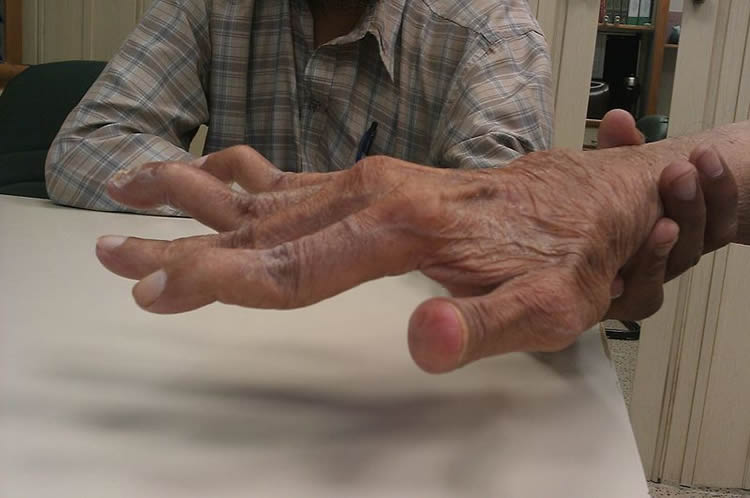Summary: Researchers have identified a genetic overlap between rheumatoid arthritis and Huntington’s disease. The findings could open the door to developing new therapeutic targets and medications to combat both conditions.
Source: UCSD
Using new analytic tools, researchers at University of California San Diego School of Medicine and the Icahn School of Medicine at Mount Sinai have decoded the epigenetic landscape for rheumatoid arthritis (RA), a common autoimmune disease that affects more than 1.3 million Americans. In unveiling RA’s epigenome — the proteins and molecules that decorate DNA and help turn genes on and off — scientists made a surprising discovery: an overlap between the causes of RA and Huntington’s disease, a fatal and incurable genetic brain disease.
The findings are published online in the May 15 issue of Nature Communications.
The research team, led by senior author Gary S. Firestein, MD, dean and associate vice chancellor of translational medicine at UC San Diego School of Medicine, said the unexpected connection between RA and Huntington’s disease opens up the possibility of new therapeutic targets and drugs for both conditions.
“We did not expect to find an overlap between rheumatoid arthritis and Huntington’s disease, but discovering the unexpected was the reason that we developed this technology. Now that we have uncovered this connection, we hope that it opens a door for treatment options for people living with either disease,” said Firestein.
RA is a chronic inflammatory disorder that causes pain and swelling in joints. As an autoimmune disease, it can also affect other organs, including heart and blood vessels. Treatment for RA has improved, but 10 to 20 percent of patients do not respond to any available medicines.
The investigative approach used by the research team involved developing a novel algorithm, or set of computational rules, called EpiSig, which integrated and reduced the number of epigenetic combinations in the genes of patients with RA. The team could then identify new cell signaling pathways.
“Comparing different types of epigenomic data is difficult because it involves a variety of different data subsets that cannot normally be analyzed together, including various methods in which DNA gets modified,” said Wei Wang, PhD, professor of chemistry, biochemistry and cellular and molecular medicine at UC San Diego School of Medicine.
“This methodology can also be used to find connections between other diseases, not just rheumatoid arthritis,” added Firestein. “As genes involved are discovered, researchers can potentially identify new treatment options and even repurpose existing drugs.”
Firestein and team studied the epigenome in cells from the joints of patients with RA. Patients with osteoarthritis, which is a disease of cartilage degeneration, served as a control group. Both data sets were analyzed through an expansive process that examines chromatin, DNA and histone modifications. The results produced 12 terabytes of data (12 trillion bytes) that were then analyzed using EpiSig.

Epigenetics, or “above the genome”, is the study of processes that alter the gene structure without changing the DNA sequence itself. These DNA modifications are essential to human growth and development and change throughout people’s lives. Epigenetic changes are influenced by a variety of environmental factors, including stress, activity and lifestyle choices.
“By revealing the comprehensive epigenetics behind rheumatoid arthritis, we now have a better understanding of this disease. More importantly, our new approach, could not only help patients with rheumatoid arthritis, but also people with other immune-mediated diseases,” Firestein said.
Co-authors include: Rizi Ai, Deepa Hammaker, David L. Boyle, Andre Wildberg, Keisuke Maeshima, Richard I. Ainsworth, Mengchi Wang, and Bo Ding, UC San Diego; Teresina Laragione and Percio S. Gulko, Icahn School of Medicine at Mount Sinai; Emanuele Palescandolo, Vinod Krishna, David Pocalyko, John W. Whitaker, Yuchen Bai, Sunil Nagpal, and Kurtis E. Bachamn Janssen Pharmaceuticals.
Funding: Janssen Pharmaceuticals, Rheumatology Research Foundation, National Institutes of Health funded this study.
Source: Gabrielle Johnston – UCSD
Publisher: Organized by NeuroscienceNews.com.
Image Source: NeuroscienceNews.com image is credited to Phoenix119 and is licensed CC BY SA 3.0.
Original Research: Open access research for “Comprehensive epigenetic landscape of rheumatoid arthritis fibroblast-like synoviocytes” by Rizi Ai, Teresina Laragione, Deepa Hammaker, David L. Boyle, Andre Wildberg, Keisuke Maeshima, Emanuele Palescandolo, Vinod Krishna, David Pocalyko, John W. Whitaker, Yuchen Bai, Sunil Nagpal, Kurtis E. Bachman, Richard I. Ainsworth, Mengchi Wang, Bo Ding, Percio S. Gulko, Wei Wang & Gary S. Firestein in Nature Communications. Published May 15 2018.
doi:10.1038/s41467-018-04310-9
[cbtabs][cbtab title=”MLA”]UCSD “Link Between Huntington’s Disease and Rheumatoid Arthritis Discovered.” NeuroscienceNews. NeuroscienceNews, 15 May 2018.
<https://neurosciencenews.com/huntingtons-rheumatoid-arthritis-9056/>.[/cbtab][cbtab title=”APA”]UCSD (2018, May 15). Link Between Huntington’s Disease and Rheumatoid Arthritis Discovered. NeuroscienceNews. Retrieved May 15, 2018 from https://neurosciencenews.com/huntingtons-rheumatoid-arthritis-9056/[/cbtab][cbtab title=”Chicago”]UCSD “Link Between Huntington’s Disease and Rheumatoid Arthritis Discovered.” https://neurosciencenews.com/huntingtons-rheumatoid-arthritis-9056/ (accessed May 15, 2018).[/cbtab][/cbtabs]
Abstract
Comprehensive epigenetic landscape of rheumatoid arthritis fibroblast-like synoviocytes
Epigenetics contributes to the pathogenesis of immune-mediated diseases like rheumatoid arthritis (RA). Here we show the first comprehensive epigenomic characterization of RA fibroblast-like synoviocytes (FLS), including histone modifications (H3K27ac, H3K4me1, H3K4me3, H3K36me3, H3K27me3, and H3K9me3), open chromatin, RNA expression and whole-genome DNA methylation. To address complex multidimensional relationship and reveal epigenetic regulation of RA, we perform integrative analyses using a novel unbiased method to identify genomic regions with similar profiles. Epigenomically similar regions exist in RA cells and are associated with active enhancers and promoters and specific transcription factor binding motifs. Differentially marked genes are enriched for immunological and unexpected pathways, with “Huntington’s Disease Signaling” identified as particularly prominent. We validate the relevance of this pathway to RA by showing that Huntingtin-interacting protein-1 regulates FLS invasion into matrix. This work establishes a high-resolution epigenomic landscape of RA and demonstrates the potential for integrative analyses to identify unanticipated therapeutic targets.






